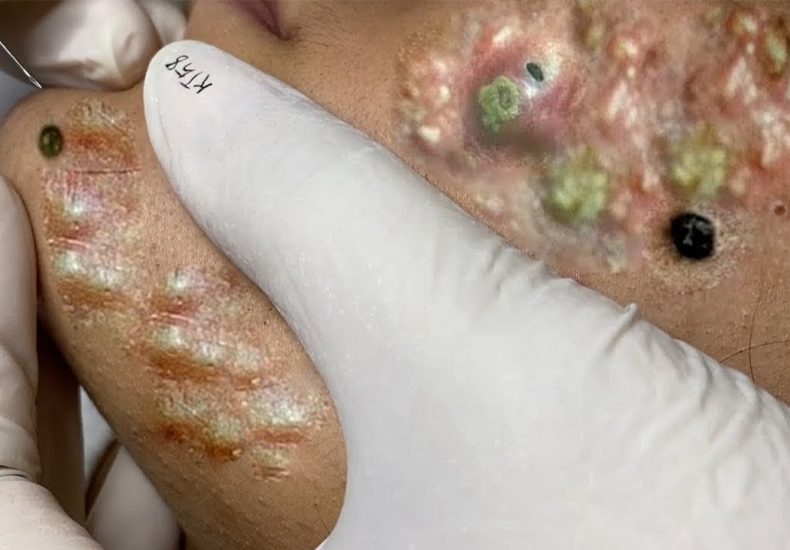
chemical peel treatment for acne | Pimples Treatment |
chemical peel treatment for acne | Pimples Treatment |
Please scroll down to watch the video.👇👇
Chemical peel treatment for acne and pimples involves applying a chemical solution to the skin to exfoliate the top layers. This promotes new skin growth, reduces acne, and improves overall skin texture. Here’s a step-by-step breakdown:
🔬 How Chemical Peels Treat Acne:
Chemical peels help by:
-
Unclogging pores and reducing blackheads/whiteheads
-
Exfoliating dead skin to prevent clogged pores
-
Reducing inflammation and acne scars
-
Killing acne-causing bacteria (especially salicylic acid)
🧪 Common Peels Used for Acne:
| Type | Ideal For | Key Ingredients |
|---|---|---|
| Superficial Peels | Mild acne, clogged pores | Salicylic acid, glycolic acid, lactic acid |
| Medium Peels | Moderate acne and scars | TCA (trichloroacetic acid) |
| Deep Peels | Severe acne scars | Phenol (rarely used due to intensity) |
✅ Steps in a Chemical Peel Treatment:
-
Consultation:
-
A dermatologist evaluates your skin type, acne severity, and sensitivity.
-
-
Pre-Treatment:
-
Stop using retinoids, exfoliants, and acne creams 3–5 days prior.
-
Clean skin before the procedure.
-
-
Application:
-
A chemical solution is applied to your face for 1–10 minutes.
-
Tingling or burning is common during this time.
-
-
Neutralization & Removal:
-
The solution is neutralized and washed off (depending on the peel used).
-
-
Aftercare:
-
Use gentle cleansers and moisturizers.
-
Apply sunscreen daily.
-
Avoid picking or peeling flaking skin.
-
⚠️ Important Considerations:
-
Downtime: Varies by peel depth (light peels = no downtime, deep = several days/weeks).
-
Side Effects: Redness, peeling, temporary breakouts, sensitivity.
-
Frequency: Every 2–6 weeks, depending on your skin and the peel type.
📌 Best for:
-
Oily/acne-prone skin
-
Post-inflammatory hyperpigmentation
-
Mild acne scarring
Chemical peels are a dermatological procedure that uses chemical solutions to exfoliate the skin, promoting the regeneration of new skin layers. This treatment is effective for managing acne and improving skin texture. Below is a detailed overview of chemical peels for acne treatment, including types, procedures, and considerations.
🔬 How Chemical Peels Treat Acne
Chemical peels aid in acne management by:
-
Exfoliating Dead Skin Cells: Removing the outer skin layers to prevent clogged pores.
-
Reducing Oil Production: Controlling sebum to minimize acne formation.
-
Killing Acne-Causing Bacteria: Certain acids have antibacterial properties.
-
Improving Skin Texture: Smoothing out acne scars and hyperpigmentation.
🧪 Types of Chemical Peels for Acne
Chemical peels vary in depth and composition, tailored to specific skin concerns:
1. Superficial Peels
-
Agents: Salicylic acid (BHA), glycolic acid, lactic acid (AHAs).
-
Ideal For: Mild acne, oily skin, and surface-level blemishes.
-
Mechanism: Exfoliates the outermost skin layer, unclogs pores, and reduces oil.
-
Frequency: Every 2–4 weeks.
2. Medium Peels
-
Agent: Trichloroacetic acid (TCA) at 20–35% concentration.
-
Ideal For: Moderate acne, acne scars, and pigmentation issues.
-
Mechanism: Penetrates the middle skin layers to remove damaged cells.
-
Frequency: Every 4–6 weeks.
3. Deep Peels
-
Agent: Phenol.
-
Ideal For: Severe acne scarring and deep wrinkles.
-
Mechanism: Deeply penetrates the skin to remove damaged cells.
-
Frequency: Typically a one-time procedure due to intensity.
✅ Chemical Peel Procedure Steps
-
Consultation: A dermatologist assesses skin type, acne severity, and suitability for the peel.
-
Pre-Treatment: Discontinue retinoids and exfoliants 3–5 days prior; cleanse skin thoroughly.
-
Application: The chemical solution is applied using a brush or cotton applicator.
-
Reaction Time: The solution remains on the skin for a specified duration, causing a controlled injury.
-
Neutralization: Depending on the peel, a neutralizing agent may be applied.
-
Post-Treatment Care: Apply moisturizers, avoid sun exposure, and follow specific aftercare instructions.
⚠️ Considerations and Side Effects
-
Downtime: Varies by peel depth; superficial peels have minimal downtime, while deeper peels require longer recovery.
-
Side Effects: Redness, peeling, sensitivity, and potential pigmentation changes.
-
Precautions: Not recommended for individuals with certain skin conditions or sensitivities.
📌 Suitability
Chemical peels are suitable for individuals with:
-
Oily or acne-prone skin.
-
Post-inflammatory hyperpigmentation.
-
Mild to moderate acne scarring.
It’s essential to consult with a qualified dermatologist to determine the appropriate peel type and concentration for your specific skin concerns.
References:
-
Leave a Reply